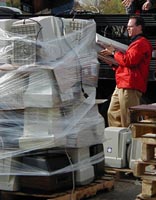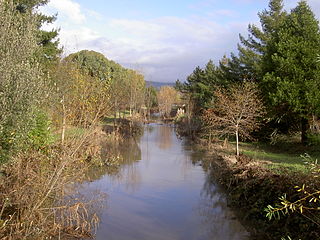The Healdsburg Transfer Station is a solid waste recycling and reuse facility in Sonoma County, California, located at 166 Alexander Valley Road, north of the City of Healdsburg. It is privately owned by Republic Services along with all other former Sonoma County transfer stations as of April 1, 2015. [1] Its coordinates are 38°39′05″N122°52′07″W / 38.6515°N 122.8686°W Coordinates: 38°39′05″N122°52′07″W / 38.6515°N 122.8686°W .

Recycling is the process of converting waste materials into new materials and objects. It is an alternative to "conventional" waste disposal that can save material and help lower greenhouse gas emissions. Recycling can prevent the waste of potentially useful materials and reduce the consumption of fresh raw materials, thereby reducing: energy usage, air pollution, and water pollution.

Sonoma County is a county in the U.S. state of California. As of the 2010 United States Census, its population was 483,878. Its county seat and largest city is Santa Rosa. It is to the north of Marin County and the south of Mendocino County. It is west of Napa County and Lake County.

California is a state in the Pacific Region of the United States. With 39.6 million residents across a total area of about 163,696 square miles (423,970 km2), California is the most populous U.S. state and the third-largest by area. The state capital is Sacramento. The Greater Los Angeles Area and the San Francisco Bay Area are the nation's second- and fifth-most populous urban regions, with 18.7 million and 9.7 million residents respectively. Los Angeles is California's most populous city, and the country's second-most populous, after New York City. California also has the nation's most populous county, Los Angeles County, and its largest county by area, San Bernardino County. The City and County of San Francisco is both the country's second-most densely populated major city after New York City and the fifth-most densely populated county, behind only four of the five New York City boroughs.
Contents
Sonoma County along with some European nations and certain other non-federal U.S. public agencies has been a leader in recycling and adopting an extended producer responsibility plan to promote waste stream recycling and reuse. [2] The Healdsburg Transfer Facility receives and processes a wide array of residential and commercial wastes in order to reduce the waste stream volume destined for landfills.

Europe is a continent located entirely in the Northern Hemisphere and mostly in the Eastern Hemisphere. It is bordered by the Arctic Ocean to the north, the Atlantic Ocean to the west, Asia to the east, and the Mediterranean Sea to the south. It comprises the westernmost part of Eurasia.

In the field of waste management, extended producer responsibility (EPR) is a strategy to add all of the environmental costs associated with a product throughout the product life cycle to the market price of that product. Extended producer responsibility legislation is a driving force behind the adoption of remanufacturing initiatives because it "focuses on the end-of-use treatment of consumer products and has the primary aim to increase the amount and degree of product recovery and to minimize the environmental impact of waste materials".

A landfill site is a site for the disposal of waste materials by burial. Landfill is the oldest form of waste treatment, although the burial of the waste is modern; historically, refuse was simply left in piles or thrown into pits. Historically, landfills have been the most common method of organized waste disposal and remain so in many places around the world.











